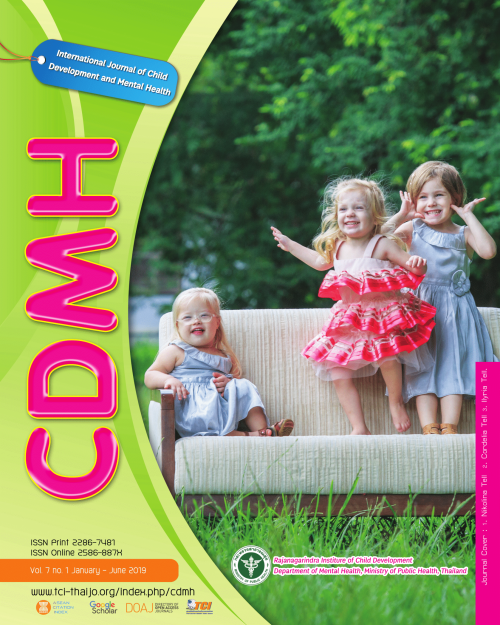Sharing Experience Of Scalp Acupuncture For Child Development And Jessie Golgi Reflex Point To Relief Spasticity
Main Article Content
Abstract
Developmental disabilities including cognition, motor performance, vision, hearing and speech, and behavior are listed as major categories of developmental disability with corresponding (ICD)-10 codes. Treatment of these disorders can be difficult; treatment often involves a combination of professional therapy, pharmaceuticals, and home- and school-based programs. Traditional scalp acupuncture systems have been reported to be beneficial but do not include the Fusiform Face area treatment zone and the corpus callosum treatment zone, which the latest brain study found to be very important in child neurological development problem. 9 child patients, aged from 3 to 18 years old and corresponding (ICD)-10 codes, were treated with Neoh Scalp Acupuncture and Jessie Point to relieve their spasticity, with a five year follow up at our acupuncture clinic. The location of the Jessie Golgi Reflex Point is near the bicep muscle distal biceps tendon where the Golgi tendon organ is. No patients have dropped out of our five year acupuncture clinic follow up. They all still continue receiving treatment at our clinic as their parents found that their children continue to improve in every aspect of development. Interviews with their parents reported that most of their children’s disabilities and spasticity improved progressively. The Jessie Golgi Reflex Point showed immediate improvement in their spasticity, whereas the spasticity of adult stroke patients in our clinic also improved with Jessie Golgi Reflex Point massage. Most children’s disabilities were found to have hypoactive or hyperactive development at their Corpus Callosum, and Neoh Scalp Acupuncture specifically treated this area. Muscle spasticity was well treated with Jessie Golgi Reflex Point massage. This report is valuable for experienced acupuncturists in treatment of their own similar patients, and also for western trained physicians.
Article Details
![]()
Creative Commons License
This work is licensed under a Creative Commons Attribution-NonCommercial-No Derivatives 4.0 International (CC BY-NC-ND 4.0)
The authors retain copyright and permit the journal the copyright of first publication
Articles, once having passed the review process and accepted for publication in the CDMH Journal, are copyrighted under the CDMH Journal, Department of Mental Health, Ministry of Public Health. Please be aware distribution of CDMH Journal content for commercial purposes without permission is expressly prohibited. However, distribution with intent to educate, advocate, or spread awareness within the general public and research communities is permitted and encouraged with the understanding that the CDMH Journal Editorial Board do not hold jurisdiction or liability for any accompanying comments, text, or information from third parties, either in favor for or against the original article’s assertions, conclusions, methodology, or content.
References
PREVALENCE AND TREATMENT OUTCOMES, Chapter 5, Publisher: Nova
Science Publishers, Inc., pp.83-131, January 2016
Allam, H., Eldine, N. G., & Helmy, G.. Scalp acupuncture effect on language
development in children with autism: a pilot study. The Journal of Alternative
and Complementary Medicine, 14(2), 109-114.2008
Cohen Kadosh K. What can emerging cortical face networks tell us about mature
brain organisation? Dev Cogn Neurosci. 2011;1:246–255.
Frank Haist, Gizelle Anzures, FUNCTIONAL DEVELOPMENT OF THE BRAIN’S
FACE-PROCESSING SYSTEM, Wiley Interdiscip Rev Cogn Sci. 2017 Jan;
8(1-2): 10.1002/wcs.1423.
Gopnik A, Wellman HM. Reconstructing constructivism: Causal models, Bayesian
learning mechanisms, and the theory theory. Psychological Bulletin.
2012;138(6):1085–1108
Jason J. Wolff, et al., Altered corpus callosum morphology associated with autism
over the first 2 years of life, Brain. 2015 Jul; 138(7): 2046–2058
Min Li, et al. “Observation on Therapeutic Effect of Five-Needle-in-Nape
Acupuncture for Treatment of Post-stroke Pseudobulbar Paralysis Dysphagia,”
Chinese Acupuncture & Moxibustion, November2009, Vol. 29No. 11, p. 873–
875
Neoh Choo Aun, M.D., Neoh Karen, Neoh Jessie; Scalp Acupuncture Treatment for
Children with Autism and ADHD; International journal of child development
and mental health ISSN 2286-7481 Vol. 5 No. 2 February – July 2017 (45-57)
M.I. Gobbini, J.V. Haxby, “Neural systems for recognition of familiar faces,”
Neuropsychologia, 45:32-41, 2007.
Perou R, Bitsko RH, Blumberg SJ, Pastor P, Ghandour RM, Gfroerer JC, Hedden SL,
Crosby AE, Visser SN, Schieve LA, Parks SE, Hall JE, Brody D, Simile CM,
Thompson WW, Baio J, Avenevoli S, Kogan MD, Huang LN. Surveillance
summaries. Suppl 2. Vol. 62. Washington, D.C.: 2013. Mental health
surveillance among children--United States, 2005-2011. Morbidity and mortality
weekly report. pp. 1–35. 2002.
Jason Jishun Hao, Linda Lingzhi Hao, Review of Clinical Applications of Scalp
Acupuncture for Paralysis: An Excerpt From Chinese Scalp Acupuncture, Glob
Adv Health Med. 2012 Mar; 1(1): 102–121.
Peniston EG, Kulkosky PJ (1989) Alpha-theta brainwave training and
beta-endorphin levels in alcoholics. Alcohol Clin Exp Res 13(2): 271-279.
World Health Organization (WHO). ICD-10:International statistical classification of
diseases and related health problems. 10th revision. World Health Organization:
Geneva, 1992.
Valero Cabre A, Pascualm Leone A (2005) Impact of TMS on the primary motor
cortex and associated spinal systems. IEEE Engineering in Medicine 24(1):
29-35.
Sivaramakrishna C, Rao CV, Trimurtulu G, Vanisree M, Subbaraju GV (2005)
Triterpenoid glycosides from Bacopa monnieri. Phytochemistry 66(23):
2719-2728.


